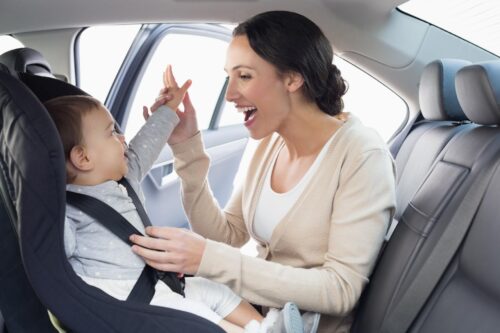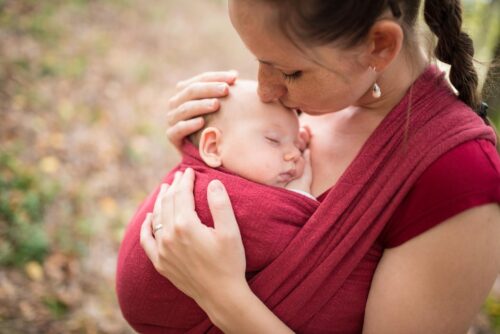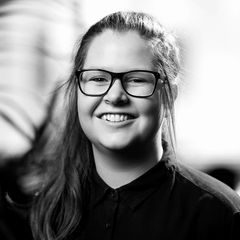Baby carriers and car seats are integral in helping keep your baby safe and comfortable during their formative years. Some baby carriers and car seats will be suitable for your baby for a few months, while others may last until they reach toddlerhood, but all have their benefits.
At Kiddipedia, we have put together a helpful guide breaking down the different types of baby car seats and carriers, their benefits, and what to consider when deciding which will be right for you and your little one!

Baby Car Seats
A baby car seat is one of the most important purchases you will make for your baby to keep them safe on the road. In Australia, car seats are mandatory for children from the very day they are born until they reach roughly seven to ten years old.
Capsule Car Seats
Capsules are a great choice for newborns and will last until they reach six months of age. Although this is seemingly a short amount of time, for busy families, this could be the ideal choice for the first six months of your baby’s life.
Baby capsules allow you to leave your little one in their car seat when carrying them to and from the car. This is fantastic for when you don’t want to wake them from a deep sleep! Many capsules also come compatible with stroller attachments. This means when you are out and about, you can simply unclip the capsule from your car and reclip it to the stroller.
Harnessed Booster Car Seats
Depending on the brand and specific seat, harnessed booster seats can be used from six months until four to eight years old. These baby car seats feature their own six-point harness to help keep your little one strapped in and safe whilst on the road.
Convertible Booster Car Seats
A convertible booster seat is the perfect option if you only want to purchase one car seat as it will suit a newborn baby right up until they are eight years old. It can be installed into your car rear-facing while your baby is a newborn. Once they reach six months old, a convertible booster seat can then be installed forward-facing and will last until they are either eight years old, or they grow out of it.
Booster Car Seats
Booster seats are designed for children aged four to ten depending on the brand, specific seat, and how fast the child outgrows their booster seat. These seats use the car seatbelt to secure your child and will elevate them so the seat belt fits them comfortably.
What Baby Car Seat is Best Suited For My Child?
Infants and Toddlers
Type of Seat – Rear-facing capsule or rear-facing convertible car seat.
Toddlers and Preschoolers
Type of Seat – Forward-facing convertible or forward-facing booster with a harness.
School-Aged Children
Type of Seat – Harnessed booster seat or booster car seat.
It’s always safest to keep your child in the car seat that’s most appropriate for your child’s size, regardless of age. Therefore Australian law also allows for the following:
- Children who are too small for the car seat that’s specified for their age group can stay in their current seat until they grow into the seat for the next age group.
- Children who are too big for the child car seat that’s specified for their age can move to the seat specified for the next age group.
- The shoulder height marker on car seats shows when your child is big enough to start using a particular car seat, when you can convert the seat to the next use, and when your child is too big for the existing seat.

Baby Carriers
Baby carriers are a great way to keep your little one close to you while you are out and about, or even when you’re getting some tasks done around the home. With a baby carrier, you can enjoy being close to your child whilst having your hands free!
Baby Carrier Wraps
Baby wraps are one of the most popular choices for a baby carrier. They are suitable for newborns to children up to three years of age. Baby wrap carriers are highly versatile as they allow you to change and adapt your wrap position to suit your child as they grow.
Baby Carrier Ring Slings
Ring slings are a stylish baby carrier that can be used for newborns to children up to the age of three. A long piece of fabric is threaded through a ring, creating a pouch to secure your baby which you can tighten and loosen as required. The only downside to this type of baby carrier is that it won’t evenly distribute your baby’s weight, so ring slings may not be the most comfortable choice if you’re planning to wear them for long periods.
Structured Baby Carriers
Structured baby carriers are ideal for children aged six months onwards. This type of carrier provides numerous sitting options, including the ‘backpack’ position, are simple to put on and highly secure.
Hybrid Baby Carriers
Hybrid baby carriers are a mix between baby wraps and structured baby carriers. They are the best of both worlds, and like wrap carriers, can be worn in multiple positions. They can also be used with newborns (in certain positions), and like a structured carrier, are very easy and simple to put on.
What to Consider When Choosing a Baby Carrier?
When shopping for a baby carrier, the most important aspect to consider is your baby’s age. While the child’s muscles are still developing, some carriers and carrier positions won’t be suitable as they are unable to properly supply neck support.
Therefore, when browsing baby carriers, make sure to check the age range the carrier is suitable. Furthermore, many baby carriers can be utilised for different positions ideal for different ages, making some baby carriers adaptable for newborns right through to children three years old.

Written by Taya Coghlan, on behalf of Babyroad, Perth’s premier baby store. You can find Taya on LinkedIn.








